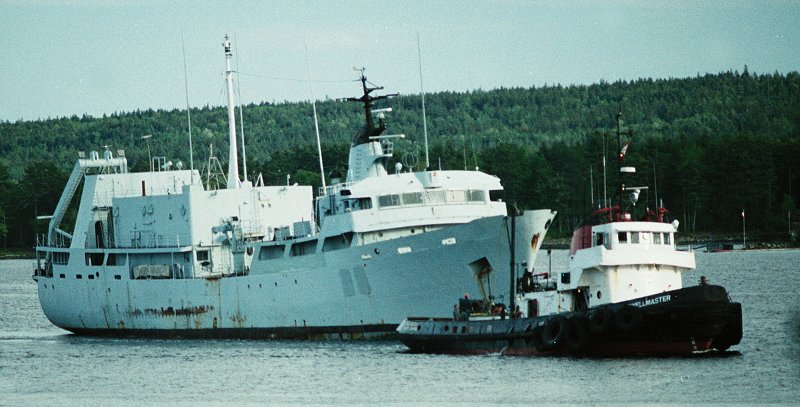All right, so I lied - IROQUOIS gets one more post out of me for the time being. I had to leave work early to pick up the car at the shop today, so I decided to make a detour and take in IROQUOIS' paying off ceremony, albeit from the Casino so I didn't exactly have a prime location.
 |
| HMCS IROQUOIS at about 1300. |
I arrived just before 1300, as guests were still arriving on this somewhat grey, overcast afternoon. Sea King #419 was circling over the Narrows, occasionally making it as far south as FMF Cape Scott or so before turning and heading back north. The crew was manning the starboard rail from the foc'st'le to the quarterdeck, and many more attended on the Jetty. I couldn't see the Jetty behind the ship, only the people gathered forward of the bow, as well as some gathered on the bridge of the MCDV and on CHARLOTTETOWN.
 |
| The crew manning the starboard rail, with Sea King #419 circling over the Narrows. |
Not too long after 1300, speeches started, of which I could only make out parts (sometimes and variously drowned out by the wind, CCG and RCAF helicopters, as well as the "Yaaahoos" (appropriate in more than one way) of the passengers of the 2-3 Harbour Hoppers that entered the water as we stood and watched the ceremony).
 |
| The first four crew members on the foc'st'le pass the paying off pennant aft. |
After the speeches, the paying off pennant was unfurled at the head of the foc'st'le, and passed hand to hand down the side of the ship, up to the 76mm gun platform, up to the bridge, and so on aft to the quarterdeck. I'm assuming it went inside the hangar, but I couldn't see that bit. After dropping back down to main deck level after the bridge superstructure, it was handed off to the Jetty. By the time the last of the pennant was unfurled on the foc'st'le, it was visible on the helicopter deck, and it took some time to complete. I would have loved to be standing at the head of the foc'st'le to get the shot of the lead crew member unfurling the pennant, with the pennant stretching off into the distance and up to the bridge; unfortunately, I did not notice any photographer in that position to get that photo. Pity.
 |
| The pennant was passed from the foc'st'le up to the 76mm gun platform, and then up to the bridge wing. |
 |
| Sea King #419 performing a flypast. The pennant hadn't yet made it to the helo deck. |
During the passing of the pennant, Sea King #419 performed a flypast running south along HMC Dockyard, and later returned to hover for several minutes over one of the defence barrier mooring points, roughly 200m away from the stern of the ship.
 |
| Sea King #419 slowing to a hover aft of IROQUOIS. |
It could be considered somewhat ironic that the oldest warship in the Navy (some claim she was the oldest commissioned destroyer in the world), was paid off to a flypast from a helicopter eight or nine years older than the ship herself.
 |
| Sea King #419 hovering over one of the defence barrier mooring points. |
 |
| Photoshop somewhat botched this panorama (the Sea King looks a bit squished), but you get the idea. |
Once the passing along of the pennant was complete, the Naval Jack (bow) and Naval Ensign (stern) were simultaneously lowered, and HMCS IROQUOIS became ex-HMCS IROQUOIS, or just IROQUOIS, and no longer a ship of the Royal Canadian Navy.
 |
| The Navy Jack, just prior to being lowered for the last time. |
 |
| Lowering the Jack for the last time. |
The crew then disembarked for the final time, and marked up the Jetty to applause, "Hip Hip Hooray", and band music.
 |
| Crew descend from the gun platform prior to disembarking. |
 |
| The jackstaff empty, the Stadacona Band marches up the jetty, as did the crew. |
IROQUOIS will now be stripped of any and all equipment that the RCN decides will be retained (some of which is required to keep HMCS ATHABASKAN running), and will probably either be scrapped or sunk in the coming years.
Farewell to IROQUOIS, after 43 years of faithful service to the Royal Canadian Navy, and Canada.








































